#pirate history
Text
maybe it's just the Radical Rediker talking, but there's something pointed in the way that, say, popular pirate media like Pirates of the Caribbean dilutes the pirate's freedom to "bring me that horizon" as opposed to, say, "plenty and satiety, pleasure and ease, liberty and power" (Bartholomew Roberts).
broadly speaking, most pirates chose the life in order to escape and revenge the hard labour, corporal punishment, overworking, and unequal pay of merchant/navy/privateer ships; or the privations of their sudden unemployment once a war was over, ignored as soon as their ability to die for the state was unneeded. yes, many were thugs, but, consciously political or not, they were responding to a particular, material reality.
the pirate's desired freedom was from the effects of exploitative modes of statehood and capital production. but popular media usually shifts this into a general desire for freedom: freedom to roam, freedom to love (usually merely a cross-class white, heterosexual union), or freedom from the personal pressures of social norms. it's a vague, ahistorical, post-Enlightenment, libertarian ideal rather than a response to a real social and economic situation.
to be clear, this only really applies to specifically the late golden age of piracy, in the first quarter of the 18th century. earlier generations of pirates/buccaneers often displayed nationalist/religious motives, and were lauded, tolerated, or even encouraged by the French and English states for aiding their fights against the Spanish and Portuguese. only the last gasp of age of sail pirates had a truly anti-national energy, and both figured themselves, and were figured by the imperial powers, as the enemies of all nations.
but if we are to valourise the late golden age pirate, at his best, his ideals were for true democracy, and the abolition of nation, hierarchy, and labour exploitation; not "the horizon". he was striking out in response to specific political, social, and economic oppressions, rather than a general individual restlessness, and that reality - and its similarities to our own - are important.
I dunno, I just... have a lot of thoughts about the defanging of piracy in modern media. obviously there were a lot of things bad about them, too, and the level of egalitarianism varied between individual people and ships. but again, if we're going to be valourising them anyway... there were idealists. and they weren't subtle about they wanted.
"I shan't own myself guilty of any murder", said William Fly in 1726. "Our captain and his mate used us barbarously. We poor men can't have justice done us. There is nothing said to our commanders, let them never so much abuse us, and use us like dogs. But the poor sailors --"
#pirates#history#pirate history#Togas does meta#Rediker is Marcus Rediker and I've only just started finally reading some of his work properly but god it's good#also if you've watched Black Sails I'd love to know how much of this energy is in there#it's a bit too ~gritty for my tastes but I get the impression it's also a bit vague about freedom over material historical politics#but i could be wrong!#obviously PotC has an ingrained anti-EIC vibe but even then it's more about ''they're enclosing the sea against us wild rovers'' than#''company captains beat us half to death just for the wealth we facilitate to be funnelled to the top while us sailors are left to rot''#and christ knows it's not interested in historical realities XD
112 notes
·
View notes
Text

Truly … I am in love with these pirates. All of them. This show is absolutely killing it and it is a MASTERCLASS in storytelling. If you haven’t started watching … fix that. Catch up. This tale is heartbreakingly beautiful 🥹
#ofmd s2#our flag means death#izzy hands#piracy#pirate history#history side of tumblr#pirate facts#special interest#ofmd
105 notes
·
View notes
Text
Historically accurate Armando Salazar :) with a lazy background
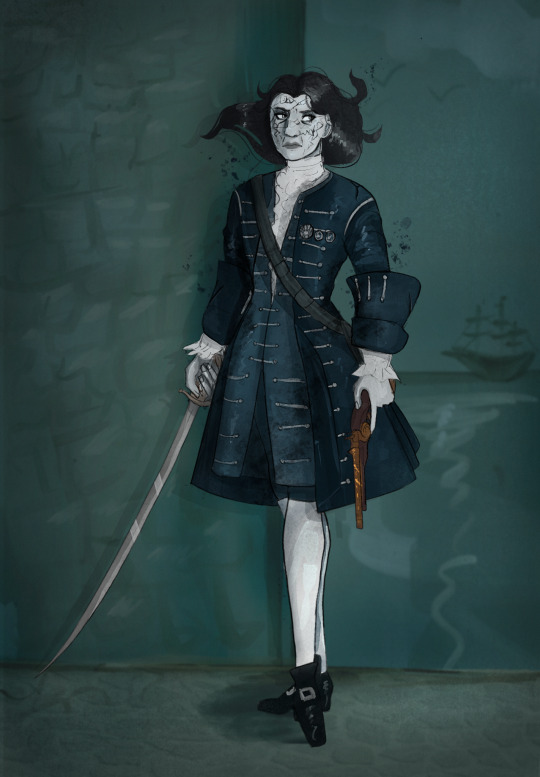
Research:
I keep trying to find military uniforms from the 1720s but, like I expected, no museums care about the first quarter of the 18th century so I sadly couldn’t find any references. I did however find this portrait with similar buttons to Armando’s coat:

And also used this illustration of Calico Jack from 1725 for inspiration!

I’ve never seen anyone roll up the cuffs of their coat like that, so I assume either it was the artist’s interpertation of what a pirate would do, or something like that. Either way I thought it was cool! I also gave him the shoulder gun-holster thing. On second thought I probably should have drawn him with multiple pistols, maybe?
I decided not to give Armando a wig so I could draw his beautiful hair. I can’t tell you if this is something pirate captains did or not because from what I’ve seen no one knows and I’ve seen illustrations with and without wigs.
Ok, that’s it! If I got anything wrong or you happen to know anything else about 1720-1730s fashion please tell me!
#potc#potc fanart#character design#18th century#pirates#historical fashion#historical#1720s#1720s fashion#pirates of the caribbean#pirate history#?#i don't remember his backstory maybe I should have looked that up#armando salazar#i do realize he looks 20 years old
57 notes
·
View notes
Text
Neck Verse
Until 1536, English pirates sentenced to hang could escape the gallows by reading the first verse of the 51 Psalm of the Bible: Miserere mei, Deus, secundum misericordiam tuam (O God, have mercy upon me, according to thine heartfelt mercifulness) Alterward, the lax laws of the day enabled court officials (who more often than not were on the payroll of said pirates) the option of granting them " Benefit of Clergy" and therefore entitled to immunity from prosecution.
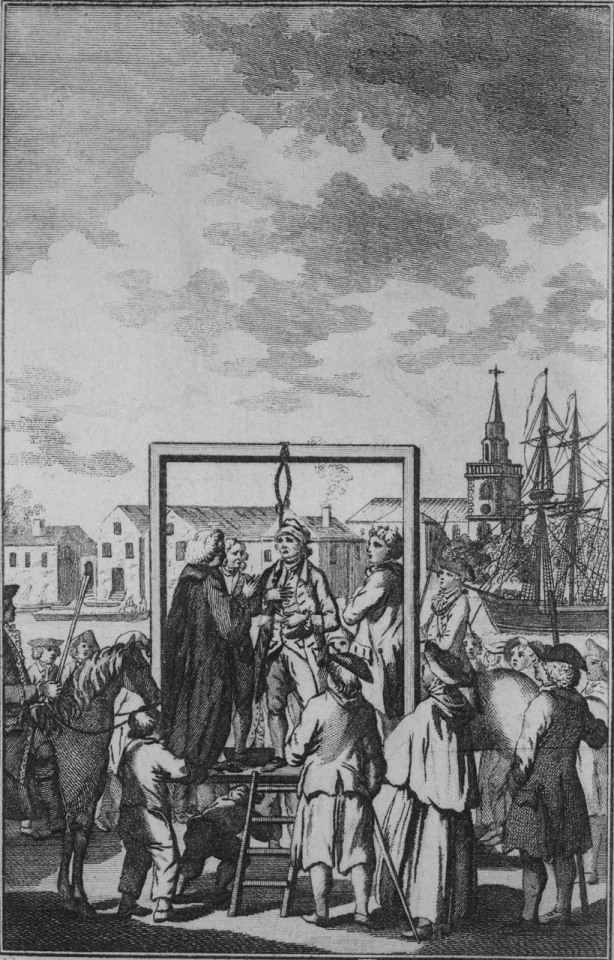
A Pirate hanged at Execution Dock, by Lt. Robert Page, 1795
Based loosely on the passage in Chronicles stating " Touch not mine anointed and do my prophets no harm, " the law itself was an effort by the church to declare its supremacy in all matters concerning members of the clergy, whether secular or civil in nature.
Didn't take long for those less savory in nature to corrupt it to the point that it encompassed not only chruch officials, but even those potentially capable of entering the priesthood by virtue of being able to read and write.
As such, the psalm, or "Neck Verse"as it was commonly known, was widely memorized by pirates in efforts to save their, well .... necks.
135 notes
·
View notes
Text

On the 22nd of November, 1718, Blackbeard would be killed off the coast of 'Ocacock' Island, along the Outer Banks of North Carolina. Robert Maynard and his men had arrived the evening before, the fifty-seven men hidden aboard two chartered merchant sloops, and would wait for sun up before approaching the anchored sloop, Adventure, at Springer’s Point.
Blackbeard and his men were unaware of what was coming that morning, as reports state that in the aftermath of the battle that it was obvious that they had spent the night carousing, with the shoreline littered with campfires, sailcloth tents and awnings, and remnants of their last haul (consisting mostly of sugar and cocoa). Its been estimated by some that this was a temporary stop, another night on dry land before plans of heading to St. Thomas to pick up a letter of marque, enabling Blackbeard to once again perform legal privateering in the Caribbean; but this assumption is often disputed by historians as an addendum to make the reader want to sympathize with the villain.

The Ranger and the Jane, the outfitted merchant sloops, would make a hard turn larboard and make their way to Blackbeard’s anchorage. As for Blackbeard noting it, it would still be hard to tell what the intent was as the ships approached in the early light, as the island was a common stopping point for many travelers in need of fresh water. It would become apparent though once his crew would spot the glint of muskets and cutlasses and a number of men swarming the upper decks.

The Adventure sloop had nine mounted guns, but Blackbeard’s crew of sixteen men was severely outnumbered, three to one. According to accounts, Blackbeard reportedly would call out “If you shall leave us alone, we shall not meddle with you.” to which Maynard would reply “It is you we want and we will have you dead or alive.” The approaching ships would fly the British White Naval Ensign, but its authenticity would be questionable, as in theory anyone could fly any flag they had managed to have gotten a hold of.
Blackbeard was cornered in shallow water with no wind to escape. As a result, the order was given and the Adventure let loose a broadsides of “swan shot, spick nails, and pieces of old iron,” killing 11 and wounding 9 of Maynard’s men aboard the Ranger, lowering Maynard’s forces to forty-six. The ensuing battle would take an hour, a series of sailing maneuvers and gunfire, concluded by a final six minute battle of hand to hand combat, once the crew of the Adventure approached close and boarded the Jane.
More men rushed up from below to meet the boarders, and shortly afterwards, Blackbeard and nine of his crew laid dead on the decks, while Maynard and 11 of his men would only suffer injuries. The remaining six pirates would surrender, now that Blackbeard had fallen. These crewmembers would later be taken to Hampton, Virginia, by early 1719.
The fall of Blackbeard is a tale that many historians have taken artistic liberties with, many embellishing the story of the battle with many colorful tidbits, such as Blackbeard being a savage opponent, that he had been shot multiple times and cut repeatedly before finally going down in battle. The tale of the battle could also be fabricated with other claims, stating that he was a vicious foe, making their success all that more impressive. Or, its more likely those additions to the story were added in by Charles Johnson in his General History of the Pirates in 1724 as yet another colorful addition to help it sell. A number of times, Blackbeard had been shot before falling in melee combat.

The facts are that Maynard and his men had killed Blackbeard on November 22nd, with Blackbeard outnumbered, 16 to 57, and his broadside was able to reduce their numbers by 11 before boarding, where he and 9 others went down. The amount of re-tellings of this event are staggering, all with new ideas proposed, what was going through Blackbeard’s mind, what his intentions were, and many more minute details to the battle that could be fabricated. Chances are though, that someone is right about something.
Blackbeard’s head would be severed from his body while lifeless upon the deck, and displayed on the bowsprit as a trophy for the return trip back to Hampton, Virginia. His body would be tossed overboard. Folklore would even go on to state that the pirate captain’s headless body swam around the Ranger three times in search of its head before finally sinking to the depths, and rumors would persist of Blackbeard’s skull being used as a drinking chalice later on before dissappearing into someone’s private collection.
In any case, the waters around Ocracoke became the permanent resting ground for arguably history’s most famous pirate, the waters of which are now home to a multitude of legends regarding Blackbeard’s unresting soul seeking both his lost head, and his fabled “buried treasure.” Some folklore claims that his headless body later washed ashore Ocracoke and became buried on land.
Some would state that Blackbeard’s demise on this date brought about the end of the Golden Age of Piracy, or the beginning of the end - the loss of such a character striking the morale of other pirates out to sea, knowing that they were not in fact invincible. Accounts of piracy however would carry on well into 1730, with some more famous pirates who had yet to even begin their careers.
(Pictured is Blackbeard as portrayed in Black Sails by Ray Stevenson, a depiction of his final battle [from Netflix’s The Lost Pirate Kingdom, although they have depicted Maynard’s vessel too large], and an illustration of the Jane and Ranger’s angle of approach by Kevin Duffus in his 2008 book “The Last Days of Black Beard the Pirate”)
74 notes
·
View notes
Text
Most people know Stede and Ed are both based on real people.
Less people know that Stede Bonnet was hung to death in December 1718 and Edward Teach was killed in battle with sailors November 1718.
And S1 is set in 1717.
This worries me for s2 or future seasons.
#not another sad ending#hopefully the last season ends before nov 1718#my mental health can’t handle their deaths#ofmd#our flag means death#ed ofmd#stede ofmd#black beard#gentleman pirate#ofmd s2#our flag means gay#golden age of piracy#pirates#gay pirates#history#pirate history#gay pirate history#1718#1717
128 notes
·
View notes
Text
GRACE O’MALLEY // PIRATE
“She was one of the most famous pirates of all time. From the age of 11, she forged a career in seafaring and piracy and was considered a fierce leader at sea and a shrewd politician on land. When she was young, she wanted to travel on an expedition with her father, she was told she couldn’t go as her long hair would get caught in the ship’s ropes. To embarrass her father, she cut off most of her hair which earned her the nickname “Grainne Mhaol” which means Bald Grace. To this day, she is seen as a symbol of Ireland and an inspiration for many songs, theatre productions and books.”

20 notes
·
View notes
Text
#history#admiral benbow#john benbow#naval history#pirate history#(kind of)#the pirate history podcast#polls#op
100 notes
·
View notes
Text
Piracy and Enlightenment
There's the historical connection between enlightenment and pirates
We all know the pirates are lawbreakers but there's a connection between enlightenment and Piracy on the same time
Piracy had been a very long time to this day, especially Golden Age of Piracy dates from 1650s-1730s
Age of Enlightenment (or Age of Reason) dates from 1685-1815 was a movement with intellectual and philosophical influences and effects.
The movement's main ideas are humanity, reason, descience and liberty. The Enlightenment influence two grandest revolutions, the American revolution and French Revolution. The two revolutions influenced other countries independence in following years
Also, there are enlightened ideas of modern democracy, including vote for rights
Pirate government system is modern democracy. They have voting election to elect new captain or new second mate.
Some enlightened ideas about natural human rights (life, liberty, and property). Enlightened philosophers wanted to improve human conditions on earth than concern with skepticism
In Piracy, being aboard on pirate ships are more civilized than life on merchant ships that merchant sailors were treated poorly there. Piracy also offered to poor men who are unemployed. Pirates may be respect to each other despite their different backgrounds.
Since American Revolution influenced by enlightenment ideals, some pirates help America free from Britain
Pirate code was influenced by enlightenment as US Constitution, despite they have different similarities on their own and each other. And it has significant on process of American democracy.
So that means Pirates are enlightened rebels on the sea
#max's corner#history#pirates history#age of enlightenment#golden age of piracy#pirate history#pirates of the caribbean#POTC#black sails#our flag means death#ofmd#treasure island
81 notes
·
View notes
Text
Imagine if OFMD season 2 had Anne Bonny and Mary Read... and they were (as some historical evidence suggests)... lesbians
#LESBIAN PIRATES LESBIAN PIRATES#ofmd#our flag means death#our flag means gay#you can do your own research on anne bonny and mary read#because whether or not they were actually gay is still up for debate#but we know that historical accuracy doesn't really stop ofmd#as it shouldn't 😎#david jenkins#rhys darby#taika waititi#ofmd season 2#anne bonny#mary read#pirate history
93 notes
·
View notes
Text

Like we said in my native language " Bravo les lesbiennes !!! "
#art#illustration#character design#pirate#pirates#lesbian#lgbtqia#lgbt#lgbtq community#lgbtq#girls#anne bonny#mary read#pirate girl#pirate captain#history#pirate history
26 notes
·
View notes
Text
okay okay I am at a cafe right now and there is a very fancy man here who is interviewing someone for the position of executive chef at a new restaurant he is opening, which I am obviously eavesdropping on, and the restaurateur was talking about how he used to be an ingredient curator for luxury resorts in, of all place, Nassau, and he complained at some length about how difficult it is to ship "acceptable" cuts of meat to an island, and I am supremely enjoying this conversation, because 300 years ago, one of Woodes Rogers' biggest problems governing the Bahamas was that none of his new colonists would actually eat tropical ingredients, so he had to continually import beef and pork there at great personal expense* and I just think its very funny that all this time later "rich white people still won't deign to eat like the locals" is still an extant problem
*one of these instances was in fall of 1718 when Rogers sent three ships to Cuba to buy meat, but on their way there the crew all went back on their pardons and turned pirate again. unfortunately they were shortly after captured by piece-of-shit sellout Benjamin Hornigold, and their subsequent trials and public executions are largely considered to mark the true death of the Pirate Republic. so make of that what you will
#....look at that. that's liquid time… serendipity…#*this would be the same incident in which my best friend Dennis McKarthy died#they built a luxury resort right on top of old Fort Nassau which is where they were executed#i wonder if this restaurant guy bought meat for that one. that would be fucked up#pirate history
87 notes
·
View notes
Text
THE QUEER DUTCH SAILOR OF THE 18TH CENTURY
Yes, yes. We have all seen many fictional works pop up lately involving queer sailors (especially pirates) living a free life, supported by their crew. But what are some real-life examples of queerness amongst sailors? How were they treat?
Well the answer is negatively. Today, I will be using ‘Sodomy Punish’d’ as an example, but I also have pirate-related ones I would like to talk about later (perhaps in a continuation of this post. This could be a long one).
Sodomy Punish’d is the English publication of a Dutch diary written by Leondert Hussenlosch (sometimes written as Leendert Hasenbosch), a homosexual sailor in 1725. He was marooned on Ascension Island by his captain and crew once it was discovered he was homosexual, being given a few pieces of equipment to live off. This includes seeds, water, a tent and some writing equipment. This diary is readily available for free online by the way, I recommend anybody interested in the topic read it as it’s short and easy (fair warning it is also very saddening. I was upset by the end of it).
Being marooned was, with no other words to describe it, complete torture. I believe he lasted 3-4 months on the island (anybody who actually took note of the time passed feel free to correct me, I am going off pure memory). He would pray near-daily to god, thanking him for keeping him alive and begging for forgiveness. However he began to experience hallucinations after a few months. He believed he could hear god saying he won’t be forgiven for he is a sodomite. He believed he could hear the fires of hell itself. Other hallucinations included ships nearing the shore.
Despite his sexuality, I think this marooning was quite kind compared to what it could have been from his crew. As mentioned earlier, he was given quite a lot of supplies. The crew also reportedly encouraged him, saying that ‘ships always come past the island at this time of year’ and ‘there’s a water well somewhere on the island’ (this was either a lie or he could not find the well in question. The comment about ships visiting the island however was very true, as it was frequently used by mariners and boucaniers at the time to hunt for meat). So perhaps he was not entirely hated but rather cast out purely as a matter of it being the ships rules.
Unfortunately, this diary does not have a very happy ending for our sailor. Eventually he runs out of fresh water completely and has to resort to drinking turtle blood, gall and his own urine. His passages get progressively shorter and emptier until the diary comes to an abrupt end. He either died from dehydration or from sickness (because drinking such liquids and eating raw meat will do that to you).
Here are some relevant screenshots.

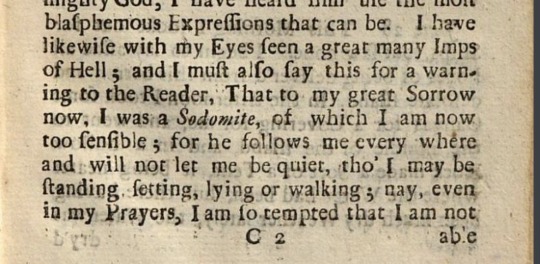

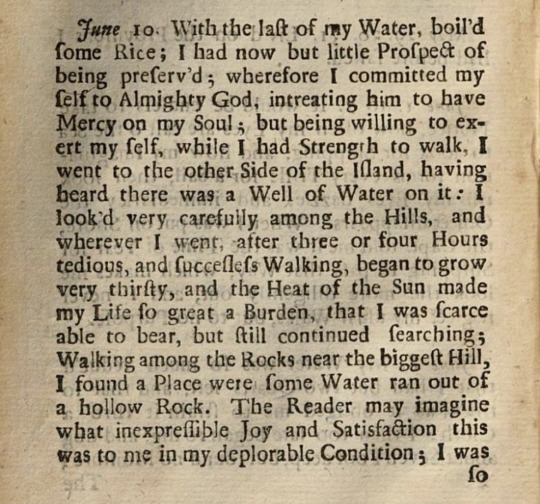

#pirate history#our flag means death#ofmd#pirates of the caribbean#black sails#lgbt history#lgbtq#lgbtq history
13 notes
·
View notes
Text
"Our Flag Means Death" provides a fictionalized take on historical pirates with a focus on queer representation. While the show doesn't strictly adhere to historical accuracy, it offers a unique lens on the lives of pirates. In the context of queer historical pirates and queer history, let's explore the themes:
1. **Anne Bonny and Mary Read:**
- In real history, Anne Bonny and Mary Read were two female pirates known for their exploits in the early 18th century. While their exact sexual orientations are not explicitly documented, their unconventional lives and the fact that they disguised themselves as men to join pirate crews challenge traditional gender norms.
2. **Edward Teach (Blackbeard):**
- Blackbeard, one of the most infamous pirates, has been the subject of various historical accounts and legends. While not explicitly portrayed as queer, his mystique and unconventional lifestyle contribute to the broader spectrum of diverse identities in pirate history.
3. **Jean Laffite:**
- Jean Laffite, a French pirate and privateer in the Gulf of Mexico during the early 19th century, is another historical figure whose sexuality is a subject of speculation. Some historical accounts suggest he may have had relationships with men, adding complexity to his historical narrative.
4. **Pirates in Non-Western Contexts:**
- The history of piracy extends beyond Western narratives. Pirates in other parts of the world, such as Cheng I Sao in China or Grace O'Malley in Ireland, may have had diverse gender identities and sexual orientations. These lesser-known stories contribute to a more global understanding of pirate history.
5. **Queer Pirates in Literature:**
- The fictionalized world of pirate literature, including works like "Pirates!" by Celia Rees or "Pirates!" by L.A. Witt and Aleksandr Voinov, explores queer narratives within the pirate genre. These stories often blend historical elements with imaginative storytelling.
6. **Queer Pirates in Popular Culture:**
- Movies like "Pirates of the Caribbean" or books like "The Pirate Hunter" by Richard Zacks, while not explicitly focusing on queer pirates, contribute to the popularization of pirate lore. Contemporary interpretations in media can influence how audiences perceive historical figures.
In essence, "Our Flag Means Death" aligns with a broader trend in media to explore and celebrate diverse identities within historical narratives. By fictionalizing elements of pirate history, the show opens up conversations about the often overlooked and underrepresented aspects of queer history, inviting viewers to consider the complexity of LGBTQ+ experiences in different historical contexts.
#our flag means death#ofmd#ofmd s2#ofmd spoilers#ofmd season 2#ofmd 2#ofmd meta#lgbtqia#lgbtqiia+#lgbtqplus#lgbtq positivity#hidden history#gay pirates#pirates#pirate history#chatgpt
12 notes
·
View notes
Text

Historical Pirate Flags
542 notes
·
View notes
Text

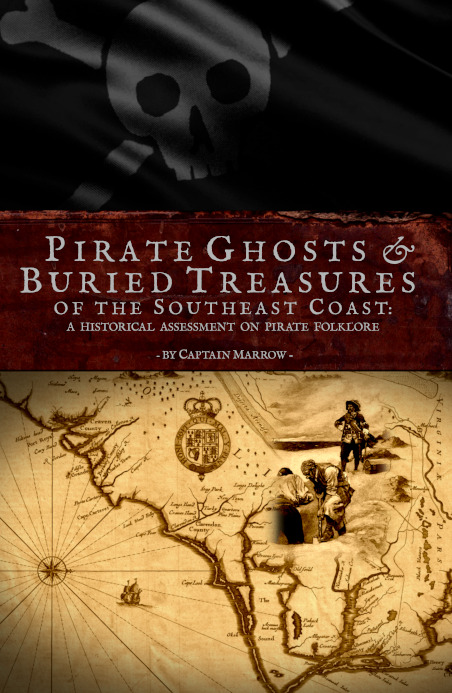

My book I just published! Over four years worth of research, traveling the coast, interviewing random locals in seaside towns, and much effort. As described on the book's back blurb above, it's a historical analysis of pirate folklore from Florida to Virginia's northernmost shores.
The inside contains nearly two hundred entries of claims of pirate hauntings and buried treasure tales associated with pirates, that date from the 1700s, newspapers of the 19th century, old brochures and folklore books, modern word of mouth tales, and online claims. Each entry is presented as the tale is known, followed by my own notes regarding historical context surrounding the claim and of its' validity. Further each tale is analyzed as to where it came from, what year it began circulating, and so on. More than just a folklore book, it's a history book 'on' the folklore.
The book recently went Live on Amazon for a number of countries outside of North America, however the listing is still in the process of becoming live for those in the US and Canada. I'll update again once it's available for us here!
https://www.amazon.com/Pirate-Ghosts-Buried-Treasures-Southeast/dp/B0CJDBLTT6/ref=sr_1_1?crid=2ZAJ6SRVDZYKU&keywords=pirate+ghosts+%26+buried+treasure+marrow&qid=1695689334&sprefix=%2Caps%2C186&sr=8-1
If you do decide to make a purchase, please consider leaving an honest review, even short one-sentence reviews help indie authors considerably. Thanks mate!
#pirate#pirates#pirate history#captain marrow#shipwrecked with captain marrow#florida#folklore#ghosts#ghost stories#haunted#spooktober
66 notes
·
View notes